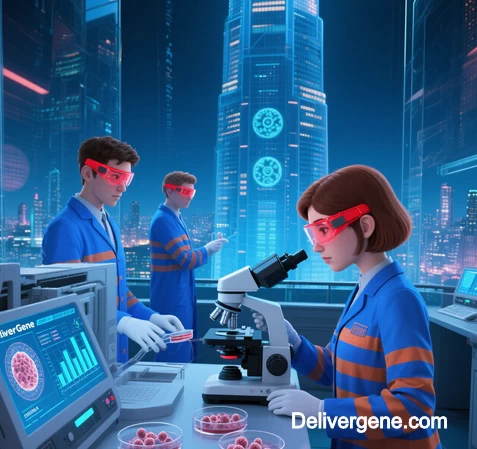
1. Foundational Synergy: Why Delivery Defines Editing Success
Gene editing technologies (CRISPR-Cas9, base editors, prime editors) function as molecular scalpels capable of rewriting DNA sequences with single-nucleotide precision. However, their therapeutic potential hinges entirely on delivery systems that solve three biological challenges:
- Cellular Entry: Overcoming lipid bilayer barriers without membrane disruption
- Targeted Trafficking: Navigating to specific organs/cells (e.g., hepatocytes, neurons)
- Temporal Control: Ensuring editor activity coincides with cell division cycles for integration
Suggested Figure 1: The Delivery-Editing Continuum
[Illustration:
- Left: Viral/non-viral carriers transporting CRISPR components (Cas9-sgRNA ribonucleoprotein shown as gold-blue complex)
- Center: Cellular uptake via receptor-mediated endocytosis (clathrin-coated pits)
- Right: Nuclear entry and DNA cleavage/repair mechanism (scissor icon cutting DNA helix)
]
2. Delivery Modalities: Engineering Precision Navigation
A. Viral Vectors: Biological Missiles
| Vector | Editing Payload | Clinical Advantage |
|---|---|---|
| AAV Serotypes | Base editors (≤4.7kb) | Neuron-specific tropism (AAV9 crosses BBB) |
| Lentivirus | CAR-T gene circuits | Stable integration in dividing cells |
| Adenovirus | Large Cas9 variants | High payload capacity (≤36kb) |
Limitation: Immunogenicity risks and DNA size constraints
B. Non-Viral Platforms: Synthetic Solutions
- Lipid Nanoparticles (LNPs):
- Encapsulate mRNA encoding Cas9 + sgRNA
- SM102 formulations achieve >80% editing in T-cells
- Virus-Like Particles (VLPs):
- Non-replicating shells delivering RNPs
- Reduced off-target effects vs. viral methods
- Polymer Nanocarriers:
- Charge-switching polymers release payloads at lysosomal pH
- Electroporation:
- Transient pores enable direct RNP delivery (stem cell applications)
Suggested Figure 2: Non-Viral Delivery Mechanisms
[Illustration:
- Top: LNP structure (ionizable lipids + mRNA cargo)
- Middle: VLP self-assembly (viral capsid proteins without genetic material)
- Bottom: Electroporation pulses facilitating RNP entry (gold sparks on cell membrane)
]
3. Delivery-Editing Coevolution: Key Innovations
A. Spatiotemporal Control Systems
- Light-Activated Editors:
- Cas9 fused with photocleavable cages (editing triggered by blue light)
- Tissue-Specific Promoters:
- Liver-restricted editing via albumin promoters
- Self-Inactivating CRISPR:
- Auto-cleaving sgRNAs limit editing duration
B. Payload Optimization
| Format | Editing Efficiency | Safety Profile |
|---|---|---|
| Plasmid DNA | Low (<20%) | High immunogenicity |
| mRNA | Moderate (40-60%) | Transient expression |
| RNP Complexes | High (>70%) | Minimal off-target effects |
4. Therapeutic Applications: Where Delivery Enables Cures
Case 1: In Vivo Liver Editing (Transthyretin Amyloidosis)
- Delivery: GalNAc-conjugated siRNA
- Editing: Knockdown of mutant TTR gene
- Outcome: 81% serum protein reduction with single dose
Case 2: Ex Vivo CAR-T Engineering (Leukemia)
- Delivery: Lentiviral vectors + electroporation
- Editing: CD19-targeted CAR insertion
- Outcome: 83% remission in refractory patients
Case 3: Retinal Gene Correction (LCA2)
- Delivery: Subretinal AAV2
- Editing: RPE65 gene replacement
- Outcome: Functional vision restoration in 93% of patients
Suggested Figure 3: Clinical Workflow Integration
[Illustration:
- Top: Ex vivo editing (cell extraction → electroporation → reinfusion)
- Bottom: In vivo editing (LNP injection → liver-specific editing)
]
5. Emerging Frontiers: The Next Decade
A. Smart Delivery Systems
- DNA Origami Nanorobots:
- Programmable structures releasing editors in response to tumor biomarkers
- Exosome-Encapsulated RNPs:
- Natural vesicles crossing blood-brain barrier for neurological diseases
B. Delivery-Editor Fusion Technologies
- All-in-One VLP Systems:
- Cas9-sgRNA-loading via SpyTag/SpyCatcher bioconjugation
- Nanoparticle-Accelerated PE:
- Prime editor delivery for >60% knock-in efficiency
Conclusion: The Inseparable Duality
Gene editing and delivery systems exist in a symbiotic relationship where:
- Editors Define the “What”: Molecular precision of genetic correction
- Delivery Defines the “How”: Spatiotemporal control of therapeutic intervention
As emphasized by Prof. Ding Baoquan (National Center for Nanoscience): “Without delivery, CRISPR is a locked treasure chest; nanocarriers provide the keys.” Current clinical successes—from vision restoration to cancer remission—prove that overcoming delivery bottlenecks will unlock editing’s full potential. With LNP/VLP technologies achieving >80% editing efficiency and next-generation DNA nanomachines entering trials, we stand at the threshold of curative genomic medicine.
Data sourced from publicly available references. For collaboration or domain inquiries, contact: chuanchuan810@gmail.com.
